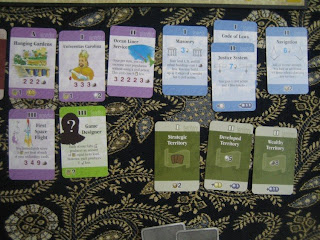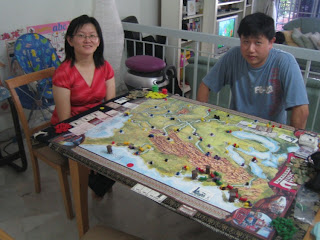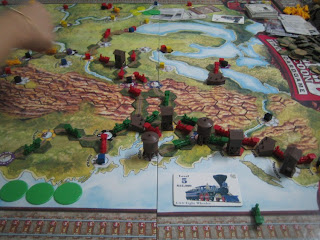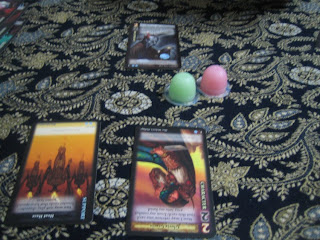Since getting into the boardgame hobby at end of 2003, I have never really thought about what my favourite games were each year. I have read other gamers writing about their favourites each year, and I enjoyed it. However I have never thought about my own favourite games for any particular year. For 2008, it occurred to me that I already have 2 favourites. Of course this may change, since we are only in June now, but this is the first time I have this feeling about favourtes. My criteria for qualifying as a "2008" game is quite loose. Not by published date. Not really by purchase date either, or first time played, but first time played is probably the closest thing to what I can call a criteria. My 2 favourite games are Through the Ages and Race for the Galaxy. Ticket To Ride: Switzerland would be third.
So far Race for the Galaxy is my most played game in 2008. Almost hitting 50 plays now. I have played Through the Ages 7 times, and that's a lot of time considering this is a long game. Han, Michelle and I played a Full Game of Through the Ages last weekend, without the non-aggression variant that Michelle and I use. I learned a few more rules mistakes that I have made (even after having played 6 games - I guess once you have assumed that's the right way to play, you don't really read the rules again and won't realise you've been playing wrong). Firstly, when sacrificing your soldiers in battle to double their strength, you lose those yellow tokens permanently. You don't return them to your yellow bank. Same thing applies when sending your people to colonise. Now that is painful. There is no easy way to add yellow tokens to your yellow bank once you lose them. In the Full Game, you also lose 2 yellow tokens permanently at the end of Ages I, II and III, so suddenly population and food matters much much more. In our game Han and Michelle almost used up all the yellow tokens in their yellow banks. We struggled to produce enough food to grow our population. With this, it seems that the Fast Food Chain is not as overpowered as I had thought, since it is actually not that easy to have that much population. But it is still very powerful. Han built it and scored 21 pts I think.
Correction, 25 Jun 2008: I checked the rules again, and found that I didn't make a mistake afterall. When sacrificing units, whether to colonise or in a military conflict, the yellow token doesn't get removed permanently. It only goes back to your yellow bank.
The other mistake I made was when a building is destroyed, the yellow token is not returned to the yellow bank. It gets returned to the idle worker pool. So in this case, the effect is less severe than I thought. You don't need to grow your population again. You just need to spend the stones to build that building again.
In our game, Han sprinted ahead on the culture track from the start and never looked back. We never managed to catch up. He set up some mutually beneficial pacts with Michelle too. Neither Michelle nor I set up any pacts. This was the first time I saw a pact in play. This was only my 2nd 3-player game. Other games were 2-player games. Han was military strong, and I kept competing with him in military strength. Michelle was a bit lax in military, since she trusted the gentlemen at the table wouldn't bully her (at least not too much). And we didn't (not much anyway). Michelle was culturally 2nd place most of the game, closer to Han than to me, because I was always a distant third. At one point Michelle had 4 colonies and James Cook as her leader, who gave 2 culture per colony per turn. That was scary. Thankfully near the end of the game I was able to catch up and overtake her on the culture track, although just barely. Michelle says that I am always like that - always "come from behind". I guess I do tend to emphasise on building a strong infrastructure to give myself a strong foundation to be competitive in the late game. In Through the Ages, I find that falling slightly behind in culture doesn't matter, because at game end, many culture points are awarded based on other aspects of your civilisation, e.g. infrastructure, science, military units, etc.

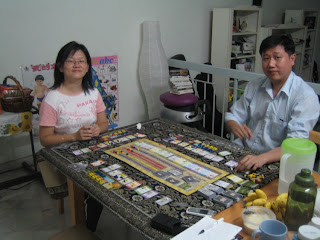
Michelle and I have played so many games of Race for the Galaxy that I can even come up with some meaningful statistics. Most game recorded were 2-player games. Only a few were 3-player games (with Han). Winning scores range from 23 to 65, average 35.9, median 34. Losing scores range from 13 to 44, average 26.6, median 26. Difference in score between winner and loser can be as big as 38, average being 9.3, and median 7. The very high scoring games were all using consume strategies. I have now found that the consume strategy can be very powerful. It is more tedious to set up, since you need to have some production worlds, you need to have good consume worlds, and you need to spend actions producing goods before consuming them for points. However once all is set up, the victory point chips just keep rolling in, unstoppable. Well, this may be because we always play the advanced 2-player game, i.e. you can choose 2 roles per round. So you can do Consume and then Produce for the next round. The consume strategy may not be as easy in 3 or 4 player games.

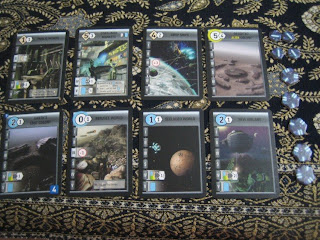

I have developed a convention for recording games of Race for the Galaxy. I record the results of all my games played. For Race for the Galaxy, I started with my usual convention, but it has since evolved to have its own convention. It started with something like:
fyv31, hcs29
which means Michelle won the game with 31 points, and my score was 29 points. Then it became:
FYV cards 19, special 10, chips 2 = 31
HCS cards 23, special 5, chips 1 = 29
which breaks down the points earned from normal cards, special 6-cost development cards, and victory point chips. Next:
FYV cards 19, special 10, chips 2 = 31 (13 cards)
HCS cards 23, special 5, chips 1 = 29 (11 cards)
I added the number of cards played by each player onto their tableau.
FYV cards 19 (13), special 10 (1), chips 2 = 31
HCS cards 23 (11), special 5 (1), chips 1 = 29
Number of cards moved to after the score of the normal cards. And I also specified the number of 6-cost development cards.
FYV[4] cards 19 (13), special 10 (1 - new galactic order), chips 2 = 31 (mostly military)
HCS[1] cards 23 (11), special 5 (1 - galactic federation), chips 1 = 29 (military)
Finally I added the start world in square brackets after the player name. I listed down the name of the 6-cost development cards. I usually describe the general strategy used. Sometimes I added a paragraph below to describe interesting aspects of the particular game.
Non gamers (and probably gamers too) will think I'm crazy.
In a recent game of Mystery Rummy: Al Capone and the Chicago Underworld, after I had done my first card draw, my hand had 10 evidence cards of different colours, and 2 gavel cards. There are only 11 different colours in the game. Needless to say, I lost that hand. The rummy god doesn't like me.






